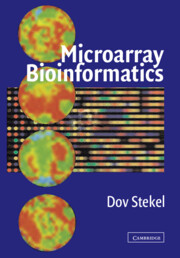Book contents
- Frontmatter
- Contents
- Foreword
- Preface
- Acknowledgments
- MICROARRAY BIOINFORMATICS
- 1 Microarrays: Making Them and Using Them
- 2 Sequence Databases for Microarrays
- 3 Computer Design of Oligonucleotide Probes
- 4 Image Processing
- 5 Normalisation
- 6 Measuring and Quantifying Microarray Variability
- 7 Analysis of Differentially Expressed Genes
- 8 Analysis of Relationships Between Genes, Tissues or Treatments
- 9 Classification of Tissues and Samples
- 10 Experimental Design
- 11 Data Standards, Storage and Sharing
- Appendix: MIAME Glossary
- Index
- Plate section
11 - Data Standards, Storage and Sharing
Published online by Cambridge University Press: 15 January 2010
- Frontmatter
- Contents
- Foreword
- Preface
- Acknowledgments
- MICROARRAY BIOINFORMATICS
- 1 Microarrays: Making Them and Using Them
- 2 Sequence Databases for Microarrays
- 3 Computer Design of Oligonucleotide Probes
- 4 Image Processing
- 5 Normalisation
- 6 Measuring and Quantifying Microarray Variability
- 7 Analysis of Differentially Expressed Genes
- 8 Analysis of Relationships Between Genes, Tissues or Treatments
- 9 Classification of Tissues and Samples
- 10 Experimental Design
- 11 Data Standards, Storage and Sharing
- Appendix: MIAME Glossary
- Index
- Plate section
Summary
INTRODUCTION
In this book we have described many different types of microarray experiment. All these experiments generate large volumes of complex data. As scientists, we need to be able to communicate the results of our experiments with other scientists. There are many reasons why scientists seek to share data, including the following:
▪ To verify the results of a published microarray experiment. It is accepted that for scientific results to be published in a refereed journal, it is necessary to provide sufficient information so that others can reproduce the experiment.
▪ To perform further experimental work based on the results. Microarray data frequently generate hypotheses that require further experimental investigation; often, microarray experiments are performed precisely to generate such hypotheses.
▪ To undertake further data analysis of the results. Sometimes it is possible to perform further data analysis beyond the analyses carried out by the researchers in their original paper, which requires full access to the data.
▪ To compare the results with other functional genomics data. It is valuable to make comparisons either between different microarray experiments, or between microarray data and data from other sources (e.g., proteomics).
▪ To developnovel data analysis methods. Bioinformatics researchers developing novel data analysis methods need data sets for testing their methods.
Data sharing is not simply a function of scientists. A microarray laboratory will typically run a number of different computer applications to capture, store, publish and analyse microarray data (Figure 11.1). In order for the laboratory to operate successfully, each of these computer applications needs to be able to exchange data with the other.
- Type
- Chapter
- Information
- Microarray Bioinformatics , pp. 231 - 252Publisher: Cambridge University PressPrint publication year: 2003
- 1
- Cited by



